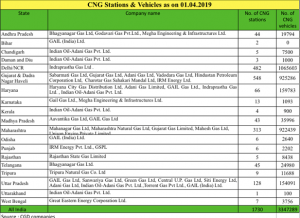Will CNG Be Driving The Next Automotive Revolution In India?
CNG is being explored and used as an alternate fuel for quite a few years. A glimpse of CNG’s potential as a clean fuel was demonstrated after it was used as an exclusive fuel powering the public transport bus system in the National Capital Region of India.
That point onwards, quite a few cities have been experimenting with CNG as a fuel to power buses, three wheelers, and passenger vehicles. As of December 2019, India has about 2.5 million CNG vehicles on the roads and has around 2000 CNG fueling stations. The table below, which is available in the public domain, gives state wise break-up of CNG vehicles and charging stations in the country:

The CNG stations and hence the vehicle sales are concentrated in a few metro cities. Lack of fueling infra is one of the main constraints that has prevented widespread usage of CNG as a vehicle fuel. There are a few technical challenges as well.
Our study of this field hints that CNG could be a viable clean fuel option which governments as well as manufacturers will be pushing aggressively till EVs become affordable for commoners.
As per a report published by Nomura Research Institute, the number of CNG vehicles in India could hit 10 million mark by 20225 if additional 5,000 filling stations are installed.
In this article, we will be looking at some key happenings in the CNG technologies and regulations to analyse what future CNG vehicles truly have in India.
Manufacturers realising CNG’s value as a clean fuel for small PVs:
Though the present numbers of CNG vehicles in India are pretty modest, one can clearly observe a consistent growth. For instance, Maruti Suzuki, the largest automaker in the country by sales volumes, sold more than a hundred thousand CNG vehicles in 2019, and reported a rise of 15.5% in the CNG sales over the last 5 years. The company expects the CNG sales to go up to 144,000 units in 2020which is a robust 36% growth. While MSIL has approximately eight models available with CNG as a fuel option, they plan to have a CNG variant for every small model.
In a news statement issued in September 2019, Volkswagen director Steffen Knapp said that VW is ready to bring CNG vehicles in the country. He also stated that Volkswagen is considering CNG as an alternative fuel for the near future before a transition to electric vehicles takes place. The company is expecting a stable policy framework from the government.
Other car makers like Hyundai and Mahindra have also experimented with the CNG vehicles.
We expect much more focus on introducing CNG in more vehicles from the manufacturers because of the newly introduced BS 6 norms. The BS 6 norms will lead to increased costs of diesel vehicles making them unviable for small vehicles. In a news statement in 2019, Tata Motors, the leading Indian car maker hinted at reducing dependence on diesel by introducing more CNG variants in 2020. Tata Motors is already manufacturing CNG kits which could be installed on different Tata models. As per this statement, diesel maybe offered as an option only for vehicles with large power trains like Harrier.
The earlier discussed move from Maruti Suzuki – introducing a CNG variant for every small car is inspired from this migration to the newer norms. Another Indian manufacturer, Mahindra is also working on CNG versions of products in its portfolio and auto enthusiasts are expecting announcements about CNG versions of XUV 300 and KUV 100.
Buses and Three wheelers
Cities like Delhi, Mumbai and Pune already have CNG buses running within the city. In December 2019, India’s first long run CNG bus was unveiled which can run 1000 kilometers on a single full fueling These buses will be leased to the Uttarakhand Government. They are equipped with composite cylinders which are 70% lighter than the conventional ones. Such technical advances are very critical to widespread usage of CNG technology.
CNG three wheelers are also gaining increasing popularity. Bajaj, Baxy, Piaggio, API already have a range of CNG powered three wheelers.
Indian government’s vision and roadmap for CNG vehicles:
The reason behind many manufacturers working towards CNG rollouts is not only the implementation of BS VI norms. There have been quite a few announcements from the government, especially the ministry for petroleum products which highlight that government is seriously considering CNG as a viable option and working towards building a strong distribution network across the country.
The most concrete step in this direction is Natural Gas Infrastructure Development Plan to set up 10,000 CNG stations over the next 10 years. The Petroleum and Natural Gas Regulatory Board (PNGRB) made announcements about extending the CNG infrastructure in 124 additional districts. This plan, if implemented, would cover 52% of India’s area and 70% of the population, which would boost the sales of CNG vehicles significantly. The government is also pushing for making CNG available at existing petrol and diesel pumps. Department for Promotion of Industry and Internal Trade (DPIIT) is working towards simplifying the process to set up CNG dispensing facilities at existing Retail Outlets for Petrol & Diesel.
At a recent conference organised by the Society of Indian Automobile Manufacturers (SIAM) on ‘Cleaner Mobility, Beyond 2020: Automotive Sector as an Agent of Positive Change’, the Joint Secretary, Ministry of Heavy Industries & Public Enterprises highlighted that government is trying to promote electric mobility but not at the cost of sidelining parallel cleaner technologies.
In May 2020, Minister of Petroleum and Natural Gas, Dharmendra Pradhan inaugurated more than 50 CNG stations in the country via an online event. These 56 stations are spread over 11 states/UTs — Gujarat, Haryana, Jharkhand, Karnataka, Madhya Pradesh, Maharashtra, New Delhi, Punjab, Rajasthan, Telangana and Uttar Pradesh. Interestingly these stations belong to 11 different entities which are a mix of public as well as private players.
In September 2020, while addressing SIAM’s 60th annual convention, Union Minister Nitin Gadkari encouraged automakers to introduce flex-fuel engines on a large scale to promote alternative fuel. This activity will also align with the government’s ‘Aatmanirbhar Bharat’ (Self reliant India) drive.
As per his statement, the government is working towards promoting the use of alternate fuels and has decided to allow automakers meeting certain criteria to set up own fuel pumps, provided they sell green fuel too.
Why is the government working aggressively towards CNG?
From all the industry happenings compiled above, one can easily see government’s serious intentions towards making CNG vehicles a part of the game. One of the most important reasons is the proven reduced environmental impact of CNG vehicles. Many research papers highlight how the use of CNG buses in Delhi helped curbing the pollution in the country’s capital. If public transport buses, three wheelers and a part of private vehicles migrate to CNG, the cities will enjoy much cleaner air.
As per a report by Nomura Research Institute (NRI) Consulting published in 2018, increasing the total number of CNG stations from the present number to 5,000 would cut down the crude oil imports by around USD 1.3 billion by 2025. CNG could be an effective tool for the government to bring down the oil imports.
According to a white paper on alternative fuels published by SIAM in 2019, four-wheeler industry would benefit from the increased spread of CNG infrastructure which will boost the sales of CNG vehicles to save CO2 and will also reduce the import bill.
Constraints/Opportunities:
For CNG technology to scale up, quite a few pieces of the puzzle need to come together.
Costs: As of now the initial costs are on the higher side due to the manufacturing challenges involved. The high cost is mostly due to the specialised fuel tanks which are costly to manufacture. Evolution of low-pressure, high-density CNG storage systems will impart flexibility of fueling the CNG vehicles and will reduce the cost.
Safety and Light weighting: Cost effective implementation of light weight technologies like Type 4 cylinders, will play a great role in popularity of CNG vehicles. Exploring options like glass composite storage tanks will also help in light weighting CNG vehicles.
Safety: Strong implementation of laws is required to prevent installation of unauthorised kits to enhance the safety of the vehicles.
Manufacturers are already working towards improving the existing technology. Maruti Suzuki has developed their own S-CNG technology which offers seamless driving experience across multiple terrains. The Tier 1s like Bosch also have drivetrains developed specially for CNG to extract its full potential as fuel.
Apart from core technologies like engines and drivetrains, many ancillary systems and components will be required for widespread adoption of CNG vehicles. Numerous specialised components like cylinder valves, compressed nitrogen regulators, gas solenoid valves, shut off valves, safety valve etc. play crucial role in CNG vehicles manufacturing and technical advances towards cost reduction and enhanced performance will bring down the costs further.
As highlighted from multiple statements from government and private agencies, CNG could be the most important and immediate supporting milestone on our way to maturation and cost feasibility of electric vehicles technology. This approach will result in a large number of CNG vehicles on roads in coming years.
For more information, contact me at sudhir.nerurkar@quanzen.com




